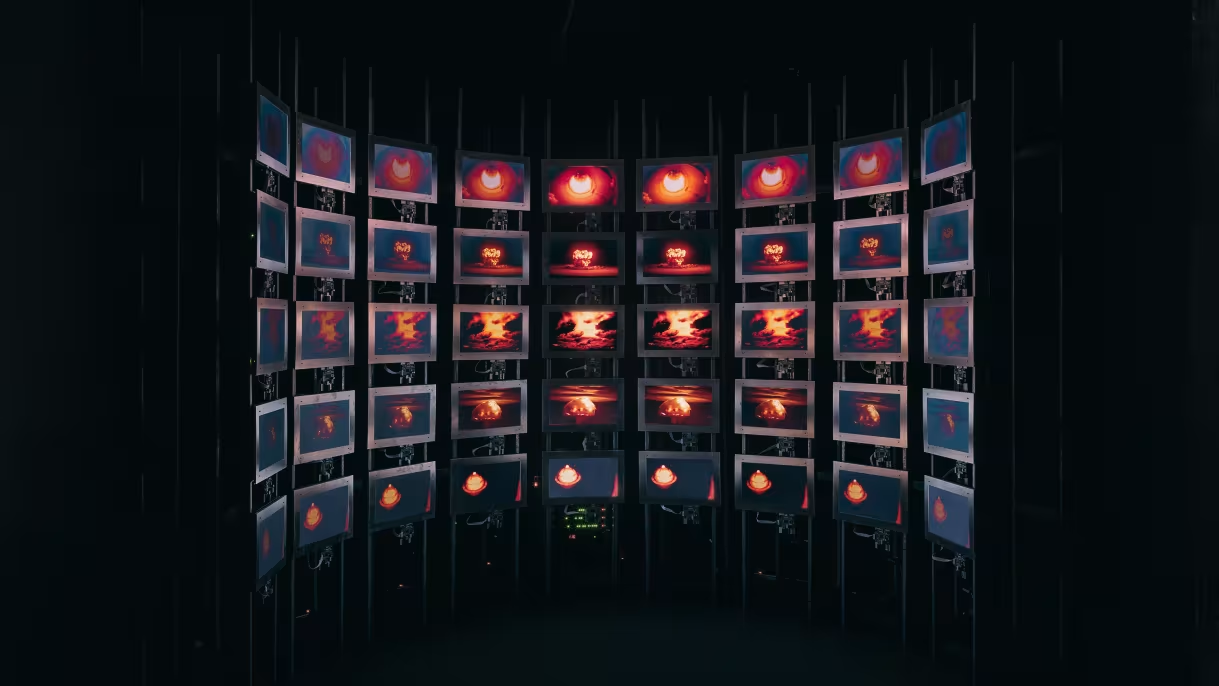

SGS Marks 50th Anniversary With Immersive Exhibit on Nuclear Weapons
The generations of Americans who remember fallout shelters and “duck and cover” air raid drills is rapidly aging, and the threat of nuclear warfare — while as urgent as ever, if not more so — is a distant concern for most young adults today.
To make that threat real for younger generations, artist Smriti Keshari and filmmaker Eric Schlosser ’81 teamed up to produce an immersive multimedia installation titled the bomb. It will debut on its international university tour as part of the exhibit “Close Encounters: Facing the Bomb in a New Nuclear Age,” on display at the Bernstein Gallery at the Princeton School of Public and International Affairs (SPIA) from Sep. 19 to Oct. 25.
“What we’re trying to do is bring attention to this issue for a new generation. When I was at Princeton, everybody knew about nuclear war and everybody thought about it. Unfortunately, the threat has only gotten worse.”Eric Schlosser ’81
Initially a grand undertaking with 30-foot screens and a live band that won much acclaim at the 2016 Tribeca Festival, the bomb in its museum format will feature 45 iPad-sized screens stacked to the ceiling — simulating a nuclear command-and-control center that envelops viewers in stunning archival footage, animation, and an electronic score by The Acid. That makes it transportable, and it will travel from Princeton to campuses around the United States and Canada. The new format and the tour are made possible by a grant from the MacArthur Foundation.
“It’s so important to bring the bomb in front of students, academics, and people who are going to have a role in shaping what the future of nuclear weapons development and strategy looks like,” Keshari said.
Princeton SPIA’s Program on Science & Global Security (SGS) is hosting the exhibit as part of a yearlong commemoration of its 50th anniversary, starting with the 2024 Bruce Blair Memorial Lecture, a panel discussion that will feature Keshari and Schlosser in conversation with Annie Jacobsen ’89, author of “Nuclear War: A Scenario,” at 4:30 p.m. on Sep. 19 in Robertson Hall.
“They recreated the bomb in a way that makes it portable and a vehicle for discussion and audience engagement,” said Alex Glaser, SGS co-director and associate professor of mechanical and aerospace engineering and international affairs. Glaser, who joined the Program 19 years ago, noted, “It provides an opportunity to get the audience interested, get them into the room, then have a conversation about it.”
Eight infographic panels and two short films produced by SGS will also be part of the exhibit. “Plan A” features a realistic simulation based on SGS modeling for a plausible escalating nuclear war between the U.S. and Russia that results in over 90 million deaths in a matter of a few hours. First released in 2017, the four-minute film has generated renewed interest worldwide since the Russia-Ukraine War began in 2022, attracting millions of views on YouTube.
“We Must Speak Boldly,” which Keshari directed, highlights SGS’s efforts to build a community of physicists who are concerned about and active in the effect to confront nuclear weapons. Founded in 2019 at SGS, the Physicists Coalition for Nuclear Reduction has mobilized a team of experts who have spoken at over 150 university physics departments to discuss current dangers from nuclear weapons policies and the need to take action. The Coalition is now going international, with talks in Europe and in Canada.
On Oct. 11, SGS will also host “Talking About the Fire,” a theater performance about nuclear weapons and the new UN Treaty on the Prohibition of Nuclear Weapons by performance artist Chris Thorpe. SGS has been a major player in the Treaty effort, which was agreed in 2017 and entered into force in 2021, including helping establish and lead its Scientific Advisory Group. That same week, the program will run the Princeton School on Science and Global Security, an annual convening of next-generation scientists from around the world to teach them to how use science and engineering to contest the threat of nuclear weapons.
SGS Co-Director and Senior Research Scholar Zia Mian, who is marking his 28th year at the Program, said these efforts collectively aim to “raise the profile of the salience of nuclear weapons as a scholarly issue, a policy question, and human, moral, and ethical concern. The weapons are not a visible part of everyday life or politics, but they have a profound impact in overshadowing humanity’s future with the possibility of nuclear war. The current enormous investments by all nine nuclear armed countries in a new generation of nuclear weapons are intended to sustain this prospect for decades to come.”
“The exhibition gives the Princeton community a moment when they can grapple with how they feel and think about the existence of nuclear weapons and the civilization-ending dangers they pose,” Mian noted. “As scholars, we believe everyone has the right to make informed choices about these weapons and the dangers they create for everyone.”

